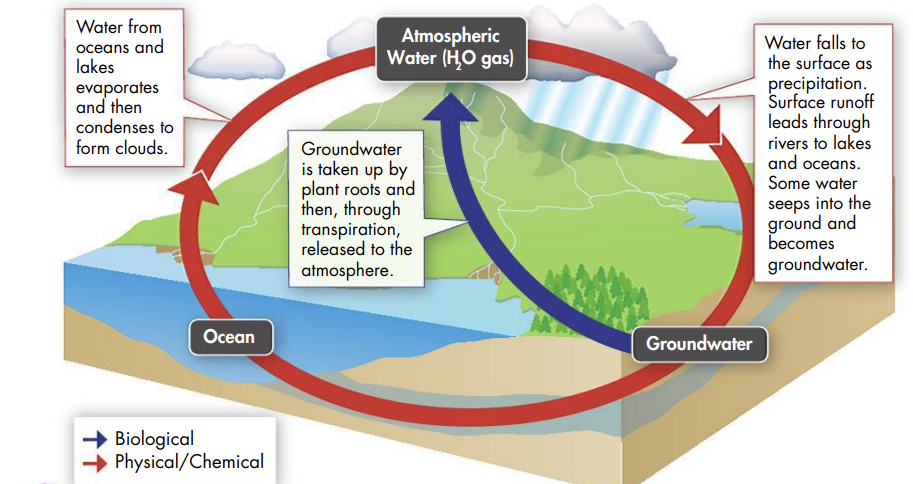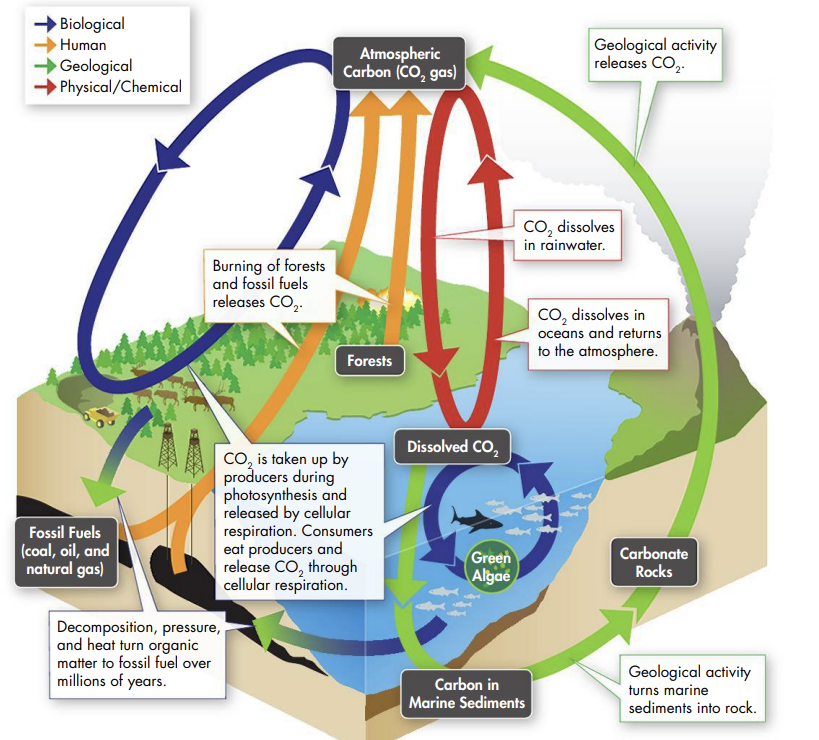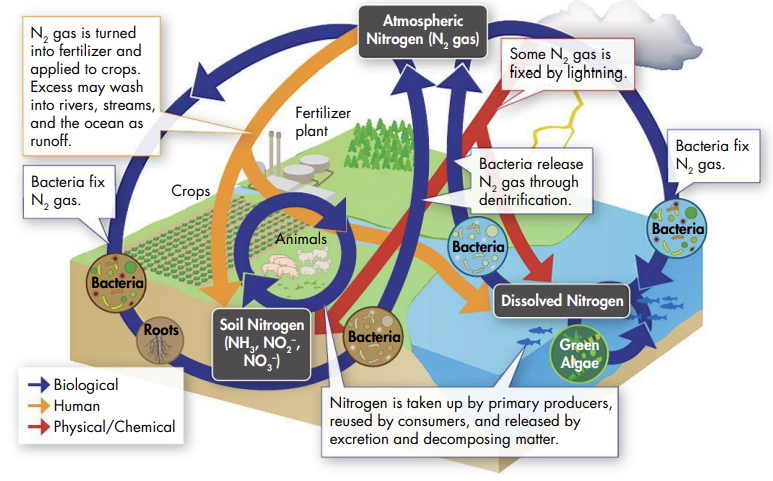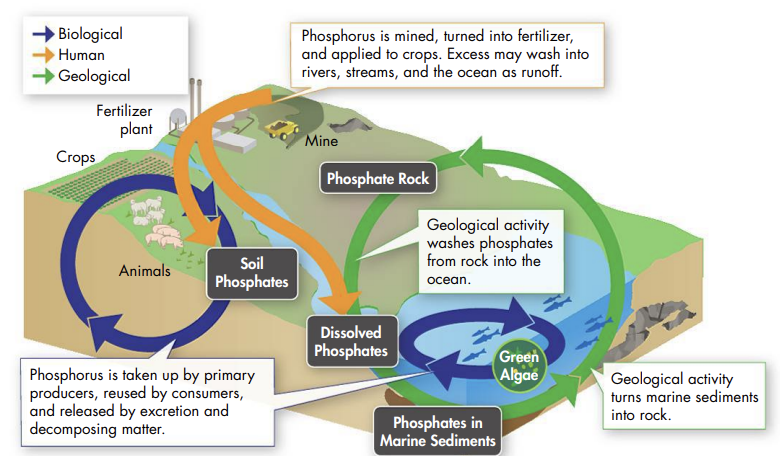Chapter 3: The Biosphere
3.1 What Is Ecology?
- The biosphere is a part of Earth in which life exists, including land, water, and the atmosphere
- It extends from about 8 kilometers above Earth’s surface to as far as 11 kilometers below the surface of the ocean
- Ecology is the scientific study of interactions among organisms and between organisms and their environment
- We depend on ecological processes to produce many of our needs, including food and clean water
Levels of organization
- The first level is simply an @@individual organism@@ itself
- A population is a group of individuals that belong to the same species and live in the same area
- An assemblage of different populations that live together in a defined area is called a community
- All the organisms that live in a place, together with their physical environment, is known as an ecosystem
- A biome is a group of ecosystems that share similar climates and typical organisms
- Our entire planet, with all its organisms and physical environments, is known as the biosphere
Biotic and Abiotic Factors
- Environment: refers to all conditions, or factors, surrounding an organism
- Environmental conditions include biotic and abiotic factors
- A biotic factor is any living part of the environment with which an organism might interact
- Include animals, plants, mushrooms, and bacteria
- An abiotic factor is a physical or nonliving factor that shapes an ecosystem
- Include things like sunlight, precipitation, and water currents
Ecological Methods
- @@All ecologists use three scientific approaches in their work:@@
- Observation involves asking questions such as “which species live here?”
- Experimentation can be used to test hypotheses
- Modeling: ecologists make models (based on data collected through observation and experimentation) to help them understand events that are difficult to study directly
3.2 Energy, Producers, and Consumers
Primary Producers
- An autotroph is an organism that is able to capture energy from sunlight or chemicals and use it to produce its own food from inorganic compounds; also called a producer
- A primary producer is the first producer of energy-rich compounds that are later used by other organisms
- The most common primary producers capture solar energy through photosynthesis
- Other primary producers capture energy through chemosynthesis
Consumers
- A heterotroph is an organism that obtains food by consuming other living things; also called a consumer
- A consumer is an organism that relies on other organisms for its energy and food supply; also called a heterotroph
- Carnivores kill and eat other animals
- Herbivores obtain energy and nutrients by eating plant leaves, roots, seeds, or fruits
- Scavengers are animals that consume the carcasses of other animals that have been killed by predators or have died of other causes
- Omnivores are animals that eat both plants and other animals
- Decomposers “feed” by chemically breaking down organic matter
- This process produces detritus, small pieces of dead and decaying plant and animal remains
- Detritivores chew or grind detritus particles into smaller pieces
3.3 Energy Flow in Ecosystems
Food Chains and Food Webs
- A food chain is a series of steps in an ecosystem in which organisms transfer energy by eating and being eaten
- A food web is a network of complex interactions formed by the feeding relationships among the various organisms in an ecosystem
Ecological Pyramids
- Each step in a food chain or a food web is called a trophic level
- An ecological pyramid is an illustration of the relative amounts of energy or matter contained within each trophic level in a given food chain or food web
- Pyramids of energy: show the relative amount of energy available at each trophic level of a food chain or food web
- Pyramids of biomass: illustrate the relative amount of living tissue available at each trophic level in an ecosystem
- The total amount of living tissue within a trophic level is called its biomass
- Pyramids of numbers: show the relative number of organisms at each trophic level
3.4 Cycles of Matter
Recycling in the Biosphere
- The biogeochemical cycle is a process in which elements, chemical compounds, and other forms of matter are passed from one organism to another and from one part of the biosphere to another
- The process involved in biogeochemical cycles can be classified in the following ways:
- Biological processes consist of any and all activities performed by living organisms
- Geological processes include volcanic eruptions, the formation and breakdown of rock, and major movements of matter within and below the surface of the earth
- Chemical and physical processes include the formation of clouds and precipitation, as well as the flow of running water and the action of lightning
- Human activity such as mining and burning fossil fuels and forests affect the cycles of matter
The Water Cycle
Water from oceans and lakes evaporates and then condenses to form clouds
Water falls to the surface as precipitation
- Surface runoff leads through rivers to lakes and oceans
- Some water seeps into the ground and becomes groundwater
Groundwater is taken up by plant roots and then, through transpiration, released into the atmosphere

Nutrient Cycles
Nutrients are chemical substances organisms need to build tissues and carry out life functions
The main nutrient cycles move carbon, nitrogen, and phosphorus through the biosphere
The Carbon Cycle
- ^^Biological Processes^^:
- Carbon dioxide is taken up by producers during photosynthesis and released by cellular respiration
- Consumers eat producers and release carbon dioxide through cellular respiration
- @@Human Activity@@:
- Burning of forests and fossil fuels releases carbon dioxide
- %%Geological Processes%%:
- Decomposition, pressure, and heat turn organic matter to fossil fuel over millions of years
- Geological activity turns marine sediments into rock and releases carbon dioxide
- ==Physical and Chemical Processes==:
- Carbon dioxide dissolves in oceans and returns to the atmosphere
- Carbon dioxide dissolves in rainwater

The Nitrogen Cycle
- ^^Biological Processes:^^
- Nitrogen fixation is the process of converting nitrogen gas into nitrogen compounds that plants can absorb and use
- Denitrification is the process by which soil bacteria convert nitrates into nitrogen gas
- Nitrogen gas is taken up by primary producers, reused by consumers, and released by excretion and decomposing matter
- @@Human Activity:@@
- Nitrogen gas is turned into fertilizer and applied to crops
- Excess may wash into rivers, streams, and the ocean as runoff
- ==Physical and Chemical Processes:==
- Some nitrogen gas is fixed by lightning

The Phosphorus Cycle
- ^^Biological Processes:^^
- Phosphorus is taken up by primary producers, reused by consumers, and released by excretion and decomposing matter
- @@Human activity:@@
- Phosphorus is mined, turned into fertilizer, and applied to crops
- Excess may wash into rivers, streams, and the ocean as runoff
- %%Geological Processes:%%
- Geological activity washes phosphates from rock into the ocean
- Geological activity turns marine sediments into rock

Nutrient Limitation
- Primary productivity is the rate at which primary producers create organic material
- A limiting nutrient is a nutrient whose supply limits productivity
- Farmers use fertilizer to nourish the soil
- In saltwater environments, nitrogen is typically the limiting nutrient
- In freshwater environments, phosphorous is typically the limiting nutrient